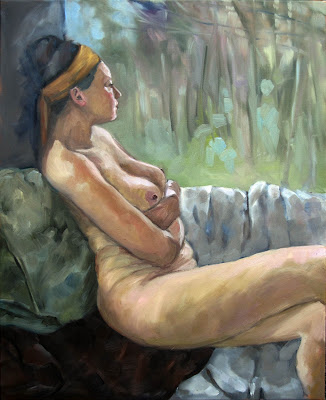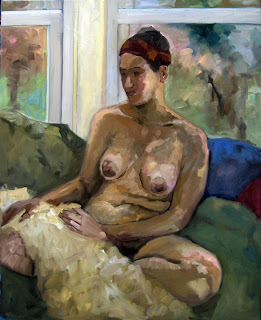 |
| “Spring fever”(figure sketch, oil on canvas, 24X30) |
Inevitably, someone will ask me, “How long did that painting take you?” This is a question I dread, as it is unanswerable.
This figure sketch was done last Saturday and took me about four hours of actual painting time—three hours with the model, and one hour to rough in a background. But that’s misleading.
I have painted this model for years. My studio is full of paintings of her—good, bad and indifferent. To some degree, every one of them was practice for this painting, just as this painting is practice for ones that will follow. Some were trips down dead ends. Some are works that stand up in their own right.
At this point, the model and I know each other pretty well. When she’s under the weather, my canvas shows it. And when she’s full of beans (far more often than not) it shows that too. Painting the same model or a small cadre of models allows the artist to learn the subject and produce work that’s perhaps not as superficial as might otherwise happen. (The same is true of painting the same locale repeatedly.)
Occasionally, a student will complain about this repetition, but I feel pretty secure in saying that they have my permission to complain after they nail it perfectly. Since I never do, I don’t expect any of them to be calling my bluff any time soon.
The Saturday before last was one of those days of—as my friend Brad Marshall so aptly describes it—“flailing around.” But in that bad day of painting (and I’ve embarrassed myself by showing you just how bad it gets) was the germ of the following week’s better (albeit hardly perfect) painting.
I’m distracted: it’s income tax time, and my oldest child is being married in four weeks. On top of that, it has been an enchantingly warm spring and I can’t help but think about being outdoors right now. Neither could the model, evidently. During a break I looked up to catch her staring out the window—and that was, in fact, the pose I was looking for. (More frequently than not, the pose I want to paint is one taken by the model when she’s not consciously posing.)
 |
| Headed for the slops pile: the prior week’s figure attempt. Promise you won’t let it get around. |
So this prior painting will go in the slops pile, where I will allow it to ferment until I am absolutely certain there is nothing left to be mined from it, at which point I’ll slash it and get rid of it. Because for every painting that is decent, there is one or more that are… not failures, exactly, but stops on the way. My friend Marilyn Fairman, who is more fiscally conservative and scrapes down paintings she doesn’t like, calls those moments “saving the canvas,” as in, “I drove over to Piseco and saved a canvas today.” (She says it’s far better than leaving it to suffer.)
We all recognize those misfires as essential to producing the work we really want to make. As my pal Mary (a writer) says, “I’m typing along, and I’ve got an awning and a flowerpot and whatever else I can throw in there; it’s really bad, it’s schlock, but I keep typing and then suddenly, if I persevere, something comes together.”
The important thing is to get past the idea that “this work is good; ergo I’m a good artist.” A good painter is simply one who persists at painting.



